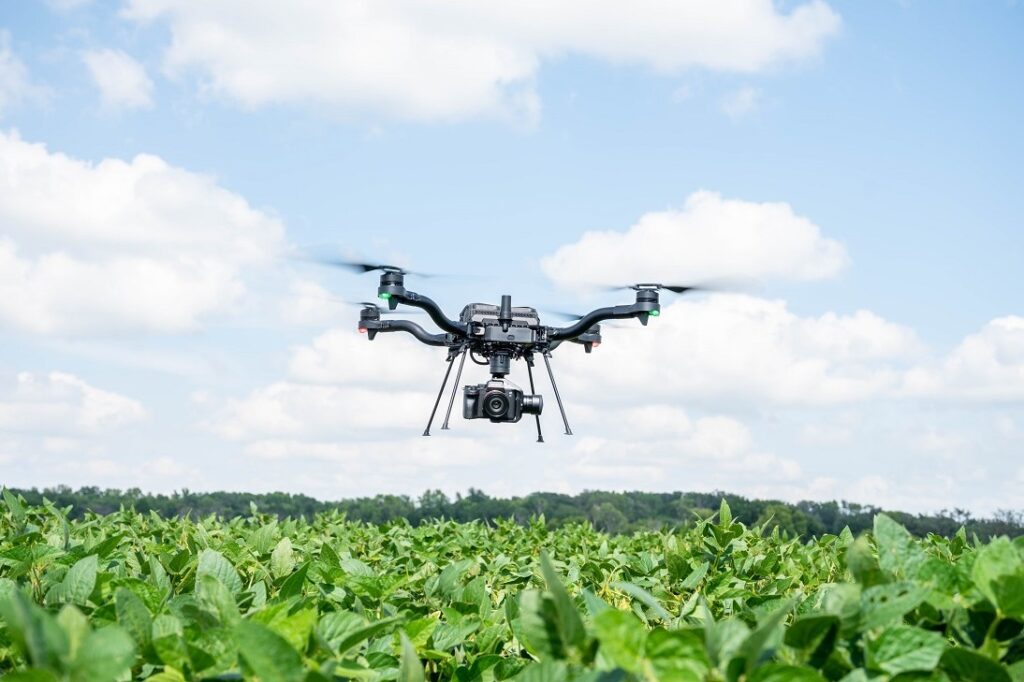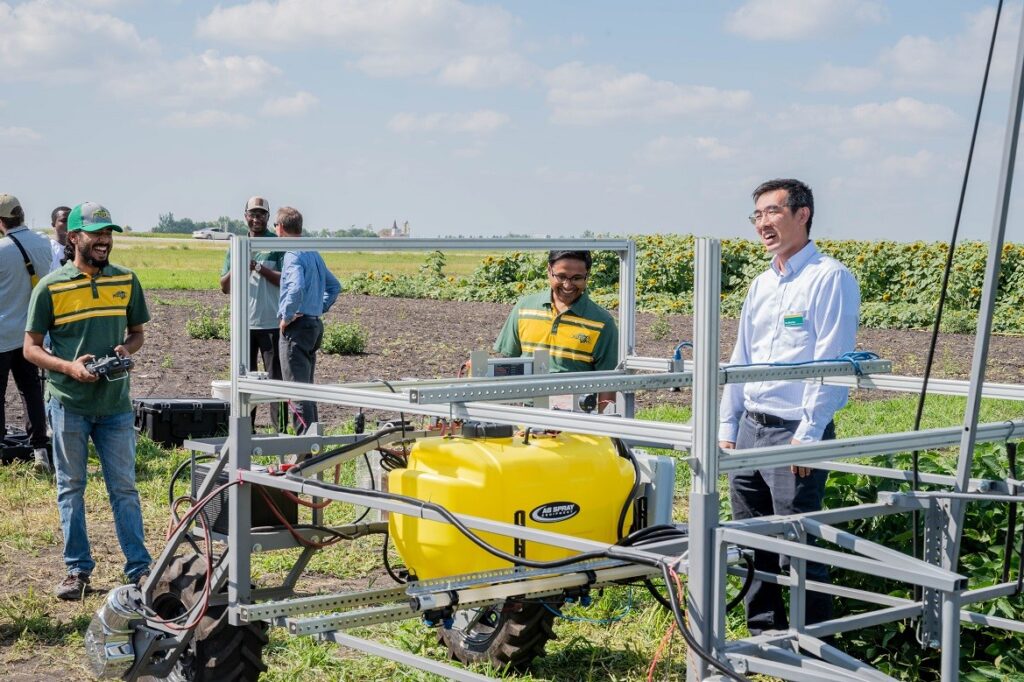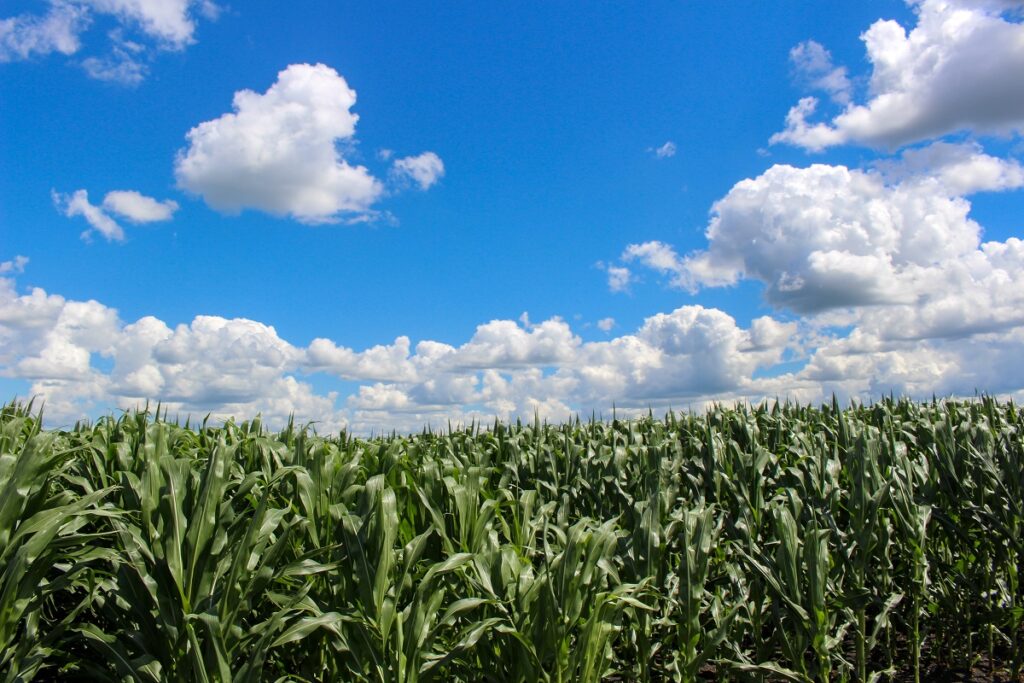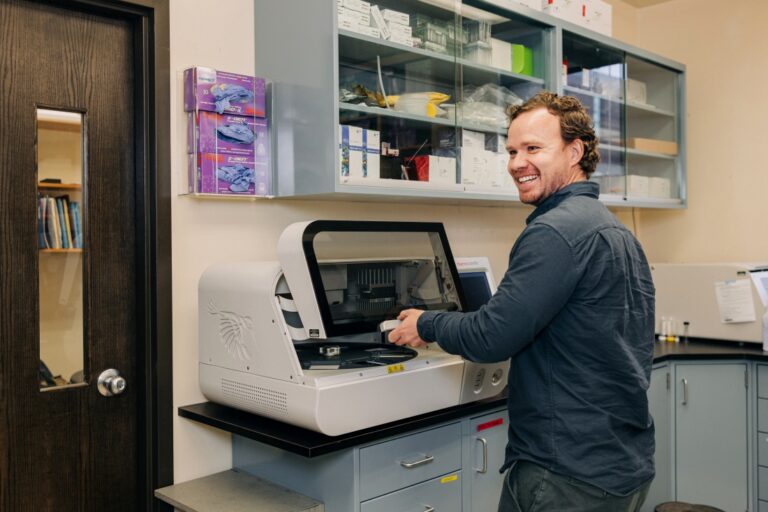Dr. Bill Wilson ’75 leverages his international network to create connections between students and the industry.
Read MoreThe Next Era of Agriculture Is Autonomous
As the number of farms declines and the world population grows, researchers at NDSU are exploring how artificial intelligence and precision agriculture practices can help protect resources, support farmers, and sustain the nation's food supply.
Story by Micaela Gerhardt | Photos by Ann Arbor Miller and Emerging Prairie | August 28, 2023

Picture this: An autonomous drone flies over a field of crops, weaving its way through spring wheat, sunflowers, and canola. The drone is searching for weeds, using a machine learning algorithm to identify, then spot-spray, the harmful invaders, shielding nearby crops from unnecessary herbicides.
Different factors contribute to the drone’s ability to distinguish pesky weeds from valuable crops. Agricultural engineers must collect thousands of big data points to train drones to respond appropriately to potential variables. What direction will the drone be flying? What is its altitude? What time of day is it? Will there be shadows? How does the weed appear from above or at different angles?
At NDSU, agricultural engineer Nitin Rai ’23 is conducting this exact research for his dissertation. Along with a team of USDA-funded researchers led by associate professor Dr. Xin (Rex) Sun, Nitin is examining the application of drones in agriculture. He has spent the past four summers in the field collecting images and the following winters in the lab working to create lightweight computer vision models that can identify weeds while flying at high speeds. These models can be integrated with small microprocessors that communicate with the nozzle, telling it when and where to spray.
Thus far, the computer vision model Nitin manually programmed has achieved 85% accuracy in identifying five different species of weeds in two unseen locations (places the drone has never flown before) in the state of North Dakota.
“This is the pace with which technology is moving right now, and this is the future of precision agriculture,” Nitin said.



Grand Farm is home to more than 450 acres of farmland designed for research, education, and testing experimental technologies. Photos by Emerging Prairie
At NDSU’s annual Three Minute Thesis competition, where Nitin earned the title of grand champion for his presentation on weed-spotting technology, he cited research that estimates the world population will reach 9.7 billion by 2050.
“With that population growth rate, farmers are expected to use advanced technologies that are fast, reliable, and sustainable,” Nitin said. “One such technology is drones in agriculture that can be used to monitor weed growth.”
Weed-spotting drones are just one piece of the puzzle — AI is currently being applied to many sectors of agriculture, including poultry farming, irrigation, robotic harvesting, autonomous tractors, and more. Ag tech entrepreneur Barry Batcheller ’77, ’10 foresaw this rapid shift and cast a vision for a fully autonomous farm by the year 2050. That vision led to the creation of Emerging Prairie’s Grand Farm Innovation Site, home to more than 450 acres of farmland designed for research, education, and testing experimental technologies, like Nitin’s drones.
“Grand Farm postulates this question: What will a farm look like in 2050? It’s not strictly about autonomous tractors or advanced farming practices, but it’s a bigger question,” Barry said. “What do you do for education on the farm? What do you do for medicine? For entertainment? For energy?”
Advancing agriculture and sustaining families in rural America will require attention to more than technological progress alone. As Barry sees it, addressing sociological and environmental questions will be just as critical.
“Those types of questions spur activity,” Barry said. “Then people say, ‘Even though I’m majoring in nursing, I have a role in that because telemedicine is involved. Even though I’m majoring in education, I have a role.’ I think if you define the problem in the proper context, you create a really inclusive ecosystem of discovery. You can ‘declare a major’ in high technology agriculture and still encompass many disciplines of education.”
He dreams of establishing the Red River Valley as the nationwide hub for ag tech advances and research that addresses these multifaceted issues — imagine a community as niche, innovative, and prosperous as Silicon Valley, but centralized in Fargo, North Dakota.
What will a farm look like in 2050? It’s not strictly about autonomous tractors or advanced farming practices, but it’s a bigger question. What do you do for education on the farm? What do you do for medicine? For entertainment? For energy?
– Barry Batcheller ’77, ’10
But to look toward the future, we must also examine the past. Throughout history, Barry says, technological advancements have equipped the agricultural industry to feed a growing world. The first big step was mechanization, moving from hand labor to machines like steam tractors that enabled farmers to be more productive. Then, during the Green Revolution in the 1950s-1980s, farmers utilized fertilizers and breeding strategies to maximize crops’ abilities to grow.
“When the country was first settled, the majority of the population was agrarian; they farmed, and that allowed people to survive and to have food and fiber,” Barry said. “Fast forward now, 200 years later, and about 1.3% of U.S. employment is comprised of direct, on-farm workers, so it’s flipped completely around, and yet they produce enough food and fiber to feed this country and a good part of the world. That productivity has come about by these stages of growth.”
This progress has led to the advent of precision agriculture practices, which empower farmers to maximize crop production by responding to the variability that exists within a field. Using technology to capture topography and soil properties — like salinity levels and ratios of sand, silt, and clay — allows farmers to treat each different area according to its own unique needs, Rob Proulx, agriculture technology systems specialist with NDSU Extension, explains.
“It’s almost like enabling practices that were more commonplace in the horse-drawn equipment era,” Rob said. “When farms were smaller, and farmers and their equipment could not get as much work done in a day, it was not uncommon to just manage your small areas in the field differently from each other, because you might get just five to 10 acres done in a day.”
During the 2018-2019 academic year, NDSU became the second school in the nation to establish a four-year precision agriculture degree program. Enrolled students examine how to utilize technology to shift from macro-level farming to the micro level while still reducing the amount of time it takes to manage a field. Where research and technology are headed next, according to Rob, is making it possible for farmers to manage crops at the individual plant level with the help of AI.
But are these advancements happening too quickly? As AI makes its appearance in more and more aspects of our daily lives, whether in agriculture or art, many people are raising ethical concerns. Nitin sees it as his role and responsibility to do as much data collection and safety testing as possible before this technology hits the market.
“A lot of testing needs to be done, especially when AI is being integrated with agriculture,” Nitin said. “That’s where engineers come in, because they test these technologies from all aspects to answer the most crucial question: How does the technology adapt to changing surroundings? Ultimately, because no technology is ideal, it’s going to fail. We should have that kind of understanding and should equip technologies to an extent that it does not harm human life, because that’s important.”
Along with ethical concerns, engineers and researchers must ensure they are meeting the practical needs of producers. When Nitin and his fellow teammates presented their drone technology research at North Dakota’s annual Big Iron Farm Show, they received feedback from farmers themselves.

“They would ask a lot of application-based questions, like, ‘How does the speed affect in-field weed identification? Is it able to precisely spray identical looking weeds? How much herbicide savings is it going to give?’ and things like that,” Nitin said. “Those are other research questions that need to be answered, and that answer comes through in-field application.”
In the coming decades, it is not guaranteed that farmers will be able to produce enough food to feed the peak projected population.
“The advancements we’ve made have been really good — mechanization, the Green Revolution, and the things we’re doing today,” Barry said, “but we’re also in the process of questioning some of the things that can turn it around if we say, ‘Gee, too much fertilizer is bad for the planet; we should stop using fertilizer,’ or if we say, ‘Gee, we’re blowing smoke into the atmosphere and too much smoke is a bad thing; we need to cut that down.’ There are forces at play that can undo some of the things that have been done, which can make it more difficult in the future to continue this curve of ever-increasing productivity.”
Many farmers are also attuned to environmental impact.
“Generally, the production farmers in this country are very sensitive to environmental things,” Barry said. “They take care of [the land] — it’s where their livelihood takes place, so farmers are generally very good stewards, but today it’s becoming an increased sensitization … How is the agricultural footprint adversely affecting the planet?”
Barry sees a need to work proactively against these headwinds, and he believes partnerships between NDSU and the industry, including companies like John Deere and AGCO that have locations in NDSU’s Research and Technology Park, will support the growth of critical research activities that will create solutions for these impending challenges.
“I think the opportunity for the University is to really bring focus on these really interesting activities and to bring business and industry in to support the growth of these activities, because clearly the industry is so interested in these things,” Barry said. “People who are fortunate enough to enter the educational space today have all these really neat things to look forward to.”
Share This Story
Related Stories
Agriculture’s Miracle Bacteria
With support from Richard '65 and Linda Offerdahl, NDSU researchers are working toward a new evolutionary event that will reduce the cost...
Read More
